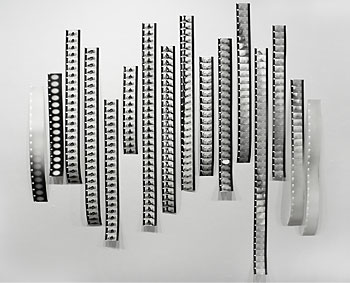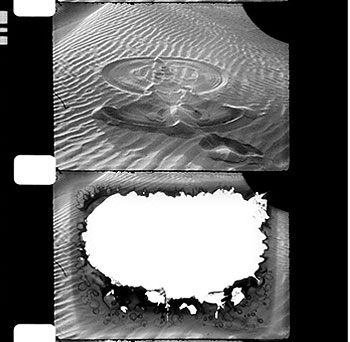


Before turning to photography, Julie Anand studied ecology, evolutionary biology, and geosciences in college. Often using or referencing natural materials and processes, her work defies media boundaries—including a tent turned camera obscura and Van Dyke prints submerged in water—and deals with principles of interdependency. Featured in the PRC's exhibition is the wall installation Sand Angel. The work consists of digitally printed strips of paper from a scanned 16mm film of a person making an angel in the sand and then erasing it, both physically and metaphorically.
Anand is currently Assistant Professor of Photography at Arizona State University (Phoenix, AZ). Before graduating with a MFA from the University of New Mexico (Albuquerque, NM) in 2005, she studied photography at Massachusetts College of Art (Boston, MA) and Harvard Extension School (Cambridge, MA). Her work has been shown at the University of New Mexico Art Museum (Albuquerque, NM) and Soho Photo (New York, NY) and her upcoming exhibitions include a two-person show with her former teacher Patrick Nagatani at the Northlight Gallery, Arizona State University (Tempe, AZ) and a solo show at the Wriston Gallery at Lawrence University (Appleton, WI).
I decided to make a mark and erase it on film-a metaphor for my ephemeral present, its record, and eventual erasure.
Jim Stone, a photographer, teacher and author, was invited to serve on the PRC's Board of Directors in 1984, a position he held through the late 1990s. Stone was elected President in 1994 and over the years hosted numerous lectures and workshops about large format photography and his own work. After studying with Minor White at Massachusetts Institute of Technology (Cambridge, MA), he received his MFA from the Rhode Island School of Design (Providence, RI) in 1975 and was responsible for initiating the photography program at Boston College (Chestnut Hill, MA).
Stone is known for his images of the American cultural landscapes, which are included in the collections of the Center for Creative Photography (Tucson, AZ), Smithsonian American Art Museum (Washington, DC), and the Los Angeles County Museum of Art (Los Angeles, CA), among others. His publications include A Short Course in Photography (1986), A User's Guide to the View Camera (1987), and Historiostomy: A Study in Repurposing Content (2001). Since 1998, Stone has been on the photography faculty at the University of New Mexico (Albuquerque, NM).